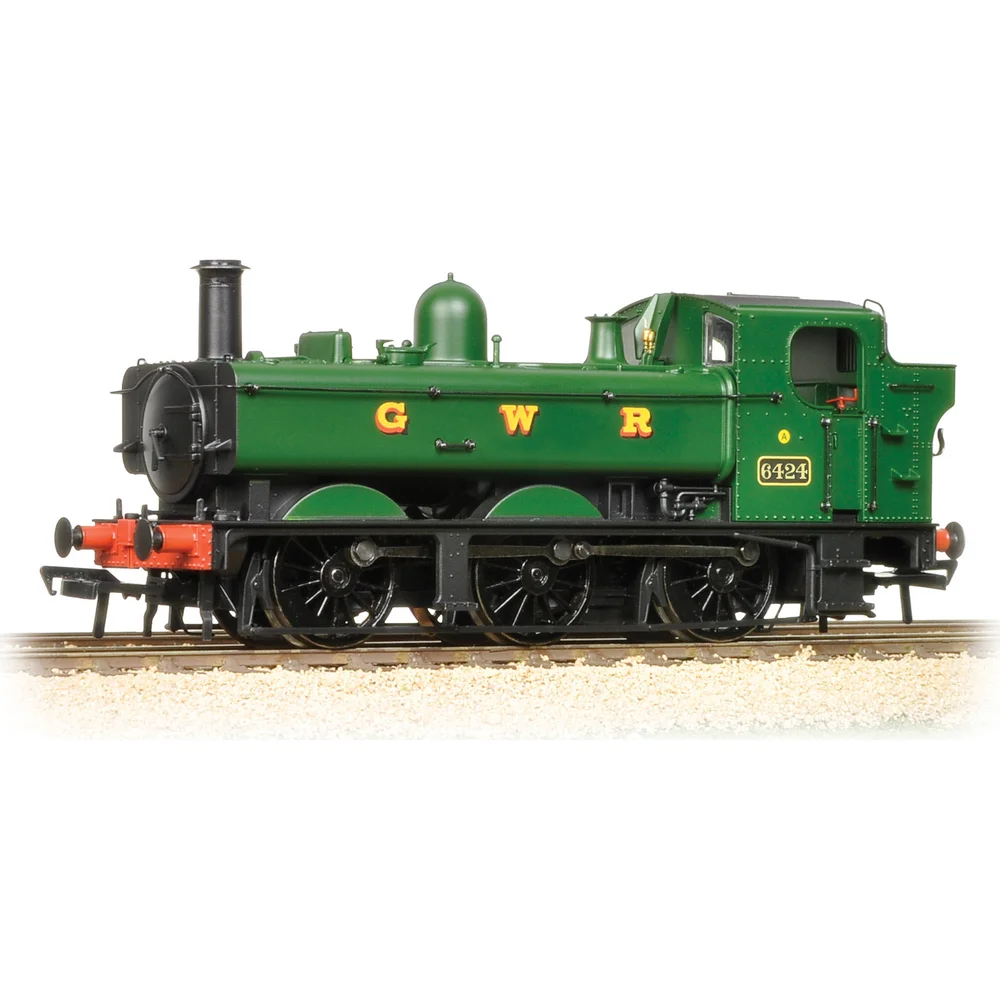Bachmann 31-635A
Great Western Railway 6400 6424 Great Western Railway Green
Tooling
Introduction & Historical Context
The Bachmann GWR Class 64xx 0-6-0PT was introduced in 2015 as a completely new tooling, designed to accurately represent the Collett-designed 64xx class of pannier tanks. These locomotives were built between 1932 and 1937 at Swindon Works, specifically for push-pull (auto-train) passenger services on GWR branch lines. A total of 40 were produced, and three survive in preservation today. The 64xx class was distinct from the more numerous 57xx and 8750 classes, with differences in dimensions, cab design, and operational equipment.
Tooling Features
- Scale: OO Gauge (1:76)
- Construction: Combination of plastic and metal chassis
- Detailing: Factory-fitted separate parts including handrails, lamp irons, pipework, safety valves, smokebox door dart, whistle and guard
- Cab: Fully detailed and painted interior with short and tall cab variants
- Couplings: NEM pockets with tension lock couplings; cosmetic screwlink couplings included
- Underframe: Brake rigging, sanding gear, footsteps, and chemically-blackened wheels
Mechanical & Electrical Features
- Motor: Coreless motor located in the locomotive
- Drive: Loco-driven wheels
- Minimum Radius: Designed to run on Radius 2 curves
- Weighting: Integrated within chassis for improved adhesion
- Lighting: No lighting fitted
- Pickups: All wheels
- Power Collection: 2-rail DC
DCC Capability
- DCC Ready: 6-pin socket
- Speaker Provision: None
Liveries Produced
- GWR Green (1835–1947)
- BR Plain Black (1948–1980)
- BR Green with Early Emblem (1948–1957)
- BR Black with Early Emblem (1949–1957)
- BR Green with Late Crest (1957–1972)
Reviews & Commentary
The model was well received upon release, with Hornby Magazine and Key Model World praising its accuracy and detailing. Reviewers noted that the tooling was entirely new and not a rehash of previous pannier tank models. The cab detailing, separately fitted parts, and smooth running performance were highlighted as standout features. Videos and reviews showcased the model running on test tracks, particularly the BR-liveried 6417.
- Sam’s Trains Review – Compares older and newer releases, highlighting build quality and value
- Moorway South Review – Covers DCC fitting, running performance, and close-up detailing
- Hornby Magazine Test Track – Features BR-liveried 6417 in realistic layout operation
- Frontington and Backwoods Railway – Showcases the 64xx in a GWR branch line setting with autocoach
- SDJR7F88 Running Session – Demonstrates BR Early Black version with sound and layout integration
Social media and forums note its appeal to GWR and BR modellers, especially those recreating branch line and auto-train operations. The model is often praised for its suitability on compact layouts and its smooth, quiet running.
Interesting Notes
- The tooling reflects the earlier body style (6400–6429) with curved cabside-bunker joins and overhanging cab roof lips.
- Designed to represent auto-fitted locomotives with screw reverse and ATC equipment.
- Footplate-mounted lubricators and front tank support variations are accurately depicted.
Class & Prototype
- Class: Great Western Railway 6400
- Traction: Steam
- Built: 1932-1950
- Total Built: 40
- Running Number: 6424
Operator & Livery
- Operator: Great Western Railway
- Livery: Green
- Era: 3 - The big 4 – LMS, GWR, LNER & SR
The Great Western Railway (1835-1947) was Britain's most innovative railway company, engineered by Isambard Kingdom Brunel with his revolutionary 7ft ¼in broad gauge system. Known affectionately as "God's Wonderful Railway" and the "Holiday Line," the GWR connected London Paddington with the West Country, Wales, and Birmingham through 3,800 miles of superbly engineered routes.
Renowned for its Brunswick green locomotives, chocolate and cream carriages, and engineering excellence centred at Swindon Works, the GWR pioneered advanced steam technology under chief mechanical engineers Daniel Gooch, George Jackson Churchward, and Charles Collett. The company's legendary locomotive classes—including Castle, King, Hall, and Manor—established performance standards that influenced British locomotive design for decades.
The only "Big Four" railway to retain its original identity through the 1921 grouping, the GWR maintained its distinctive corporate culture until nationalisation in 1947. Today, the company's engineering legacy lives on through extensive preservation efforts, heritage railways, and detailed model railway recreations that celebrate the finest traditions of British steam railway operation.
